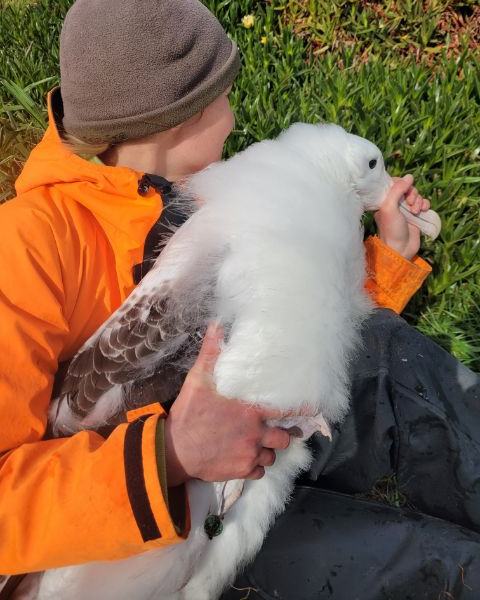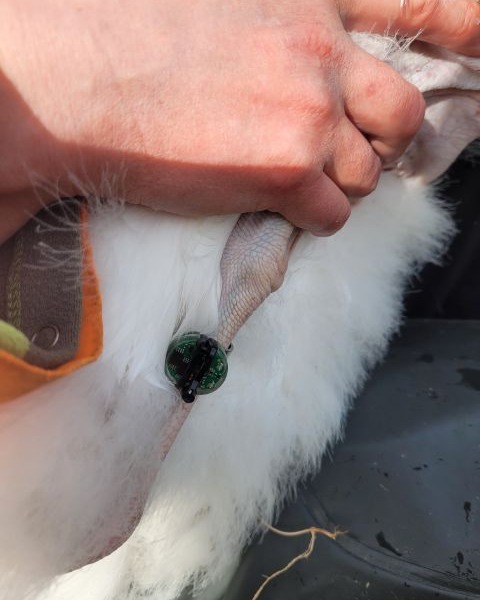 "You always want a dog that wants to work, that’s first and foremost, they have to enjoy what they are doing. Rodent dogs need to have a certain level of prey drive as they are effectively using their natural ability to hunt to find the invasive species. However, a dog working at an airport has to want to search but also has to be calm and relaxed around big crowds. The job determines what qualities you will look for in selecting a dog."
"You always want a dog that wants to work, that’s first and foremost, they have to enjoy what they are doing. Rodent dogs need to have a certain level of prey drive as they are effectively using their natural ability to hunt to find the invasive species. However, a dog working at an airport has to want to search but also has to be calm and relaxed around big crowds. The job determines what qualities you will look for in selecting a dog."
ACAP Secondee, Naomi Cordeiro with her detection dog, Sammy; photo supplied
New Zealand’s Conservation Dogs Program (CDP), which is managed by the Department of Conservation, has welcomed detection dog-handler, Naomi Cordeiro for her ACAP Secondment. Members of the CDP will host Naomi as she immerses herself with its world-class detection dog teams where she will learn new conservation techniques as part of her Secondment.
Helen Neale, Conservation Dogs Programme Manager at the Department of Conservation commented: "The Conservation Dogs Programme is always keen to support visits from overseas dog handlers working in conservation – the exchange of information around how dogs are being utilised on other projects is so valuable and supports our ongoing learning as a programme. It also connects us both with new and emerging applications for our dog handler teams."
Originally from Scotland, Naomi now lives in the Falkland Islands/Islas Malvinas*, having moved there in 2017 for a job in biosecurity with the government. Her interest in detection dog-handling was sparked when she saw detection dog teams working on a biosecurity detection dog programme following the successful eradication of rats and mice from the main island of South Georgia (Islas Georgias del Sur)*.
“I became a bit of a groupie to the dog teams, and so when the job came up, I applied and was successful. I did my initial training in Virginia, USA with Working Dogs for Conservation, I’ve been to the UK to train with a specialised conservation detection consultancy there, and this year I’m doing a week’s training in Holland.”
Naomi currently provides biosecurity services in the South Atlantic with her consultancy, South Atlantic Detection Dogs (SADD). The detection dogs ensure vessels and cargoes are rodent-free before they journey onwards to rodent-free islands, a conservation measure that safeguards the region’s wildlife including priority populations of ACAP-listed species. However, biosecurity is just one area of application for detection dogs in conservation, and through her secondment with NZDOC, Naomi aims to develop her dog-handling skills further in order to expand SADD’s conservation services to include the use of detection dogs to assist with burrowing seabird surveys, and detecting occupancy.
“I’m excited about the possibility of bringing a new technique to this corner of the world that we know has worked elsewhere but so far haven’t had the capacity and knowledge to deliver. If we can get a dog team up and running to support conservation in a new way, that would be wonderful,” she said.
 Naomi and detection dog, King who is sniffing out a fishing vessel for rodents before its onward journey to a rodent free island in the South Atlantic
Naomi and detection dog, King who is sniffing out a fishing vessel for rodents before its onward journey to a rodent free island in the South Atlantic
Filling data gaps for ACAP-listed species is identified by the Agreement’s Advisory Committee as a priority task in its Work Programme. With the population and distribution of White-chinned Petrels Procellaria aequinoctialis on islands in the South Atlantic poorly understood, the objectives of Naomi’s secondment will lead to progress in addressing that gap. The use of detection dogs for burrowing seabird surveys and detecting occupancy is a technique recognised by ACAP, and employed by New Zealand’s Department of Conservation. Naomi is excited at the chance to immerse herself with NZDOC’s world-leading experts and apply her newfound knowledge back home.
“[It] will be interesting to compare their invasive species detection to how we do things…I’m hoping to be able to work with dog teams that work on protected species, such as petrels and kiwis. Specialised burrowing seabird detection dogs work in NZ to help with census data and mapping distribution. This is something we don’t use dogs for in the Falklands/Islas Malvinas yet, but I think could be a great human-dog collaboration to better understand our burrowing seabirds.”
Fostering collaboration between Parties is a key objective of ACAP Secondments. The first-hand experience Naomi will receive from training with NZDOC's Conservation Dogs Program detection dog-teams not only strengthens partnerships between Parties, but is an aspect of her secondment near impossible to learn remotely, and vital to build the skills needed as a detection dog-handler. Luckily training, says Naomi, is one of the parts of the job she really loves.
“When you live on a small, isolated island, opportunities to see other dog teams working are pretty limited so I’m really looking forward to seeing a variety of dog teams do their thing. I love learning, so training for me is something that you just have to keep on doing. Lastly, I’ve very kindly been invited to the CDP Hui and training camp, which is their annual get together for all their dog teams, which I’m sure will be an invaluable way to speak to as many practitioners as possible and soak up as much info as I can.”
Longer term, building this capacity in the South Atlantic will enable SADD to train additional dogs and handlers, thereby widening the scope of conservation services that can be provided by detection dog-teams in the region.
Follow Naomi as she posts updates on her ACAP Secondment with NZDOC at her Instagram account, @south_atlantic_detection_dogs.
16 August 2023
*A dispute exists between the Governments of Argentina and the United Kingdom of Great Britain and Northern Ireland concerning sovereignty over the Falkland Islands (Islas Malvinas), South Georgia and the South Sandwich Islands (Islas Georgias del Sur y Islas Sandwich del Sur) and the surrounding maritime areas.


 English
English  Français
Français  Español
Español 
 "You always want a dog that wants to work, that’s first and foremost, they have to enjoy what they are doing. Rodent dogs need to have a certain level of prey drive as they are effectively using their natural ability to hunt to find the invasive species. However, a dog working at an airport has to want to search but also has to be calm and relaxed around big crowds. The job determines what qualities you will look for in selecting a dog."
"You always want a dog that wants to work, that’s first and foremost, they have to enjoy what they are doing. Rodent dogs need to have a certain level of prey drive as they are effectively using their natural ability to hunt to find the invasive species. However, a dog working at an airport has to want to search but also has to be calm and relaxed around big crowds. The job determines what qualities you will look for in selecting a dog." Naomi and detection dog, King who is sniffing out a fishing vessel for rodents before its onward journey to a rodent free island in the South Atlantic
Naomi and detection dog, King who is sniffing out a fishing vessel for rodents before its onward journey to a rodent free island in the South Atlantic


 The
The